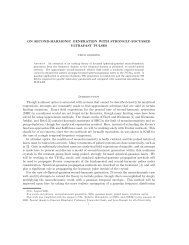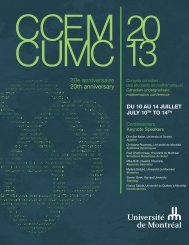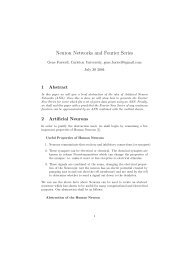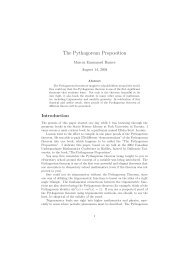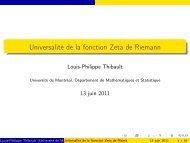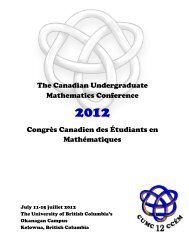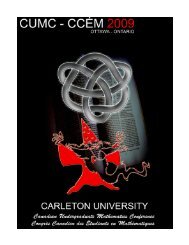booklet - CUMC - Canadian Mathematical Society
booklet - CUMC - Canadian Mathematical Society
booklet - CUMC - Canadian Mathematical Society
Create successful ePaper yourself
Turn your PDF publications into a flip-book with our unique Google optimized e-Paper software.
WEIGHTING TEST RESULTS TO IMPROVE ROC CURVES PRECISIONDÉBORDÈS JEAN-BAPTISTEHow to determine the ability of a test to classify individuals into groups like healthy/diseasedor fraudulent/not fraudulent transaction? Receiver Operating Characteristic help usidentify the best model to do so. It also enable smart decision-processes by showingthe cost of raising the sensibility of a test.Is it possible to use similar test results obtained from another population to be moreprecise in our analysis? Empirical weights given to the results of different experimentspermits to make a trade between increased biases to maximise the precision level.In our study we try to see to which extent and how using weights can help usimprove ROC curves.A PROOF OF HILBERT’S WEAK NULLSTELLENSATZ USING MODEL THEORYEESHAN WAGHModel theory is a branch of logic that deals with the study of mathematical structures.In particular, model theory has a very close relationship to abstract algebra andalgebraic geometry. The aim of this talk is to first provide a brief introduction to modeltheory. We will introduce important concepts in model theory such as elementaryequivalence, elementary extensions and model completeness. Then, we will give aproof of Hilbert’s Weak Nullstellensatz using these tools. That is, we will show if K isan algebraically closed field and I is a proper ideal of K[X 1 , . . . , X n ], then there existsa ∈ K n such that for all f ∈ I, f(a) = 0. This talk is aimed at the general mathematicalaudience and will assume basic familiarity with ring theory concepts such as rings,fields, ideals, quotient maps, etc.Required Background: basic ring theory: fields, ideals, etc.GEOMETRIC GROUP THEORY AND GROMOV’S THEOREMEHSAAN HOSSAINGiven a group G generated by a finite symmetric set S, we can draw the Cayleygraph Γ S (G). This is a starting point of geometric group theory: comparing geometricinformation from Γ S (G) to algebraic properties of G.For example, the group G has polynomially-bounded growth if the number of pathsin Γ S (G) of length n (starting at the origin) is bounded by a polynomial of n. Some examples:finite groups, abelian groups, nilpotent groups, and nilpotent-by-finite groups.Actually, a celebrated theorem of Gromov states that these are *all* the examples! A recentproof of this theorem, due to Bruce Kleiner in 2008, makes surprising use of toolsfrom other branches of math, such as functional analysis and Lie theory.In this talk, we will investigate the Cayley graphs of some familiar groups and drawlots of pictures. I will also give an overview of Kleiner’s proof. Don’t forget yourfavorite polynomial!Required Background: Group theory and a good fashion sense.25



